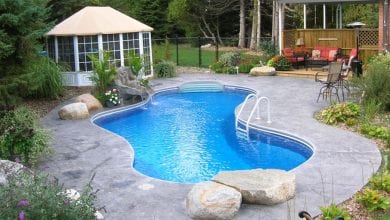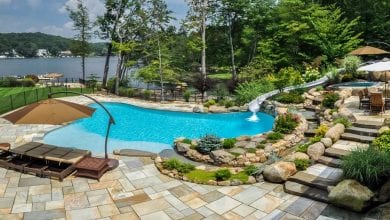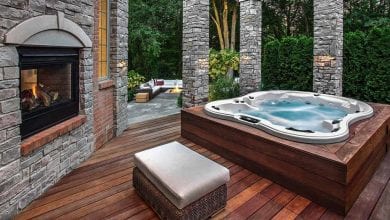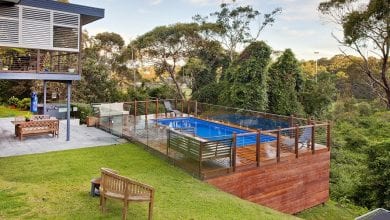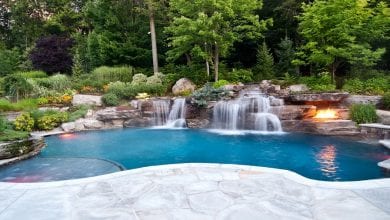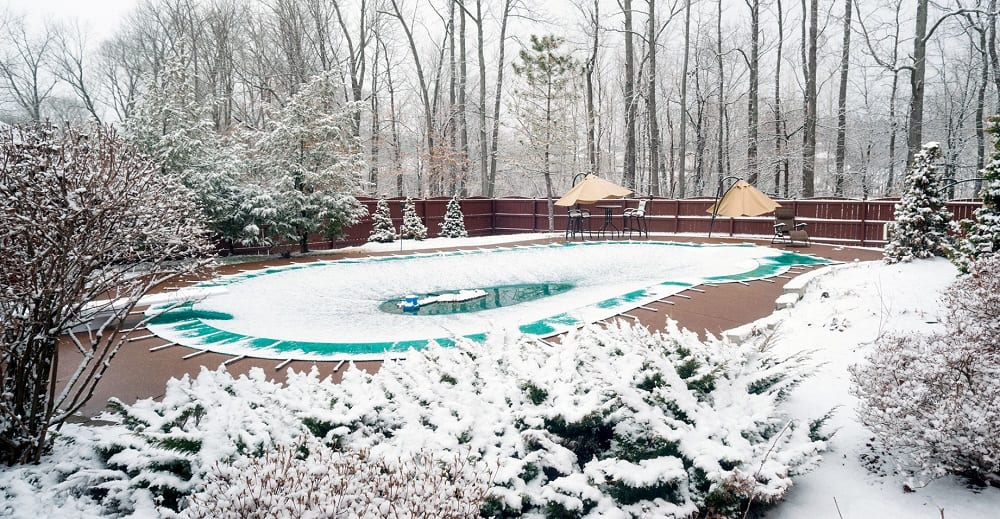
How To Winterize A Pool?
There comes a time at the end of the warm season where you know what is coming. That’s right, the winter months are sad for any pool owner, but before you start dreaming of more sun, it is important to learn how to winterize a pool. To keep it in top condition, pool maintenance doesn’t start and end with vacuuming and adding chemicals. We’re going to take a look at what it takes to ensure the pool is safe for winter. That way, when the temperature rises again, it can be enjoyed properly, without any unwanted surprises.
Why Winterize A Pool?
Many people put the winterizing stage to their back of their mind so they can fully enjoy the summer, but even those with mild winters that are the envy of those inc older places need to take steps. Anyone with a particularly chilly cold season will need to take a different approach, which can mean a little more work but learning how to winterize any pool doesn’t take long.
For a start, the bugs of summer seem to be never-ending, but they are cleared when you are on top of the maintenance. A quick sweep with the pool net gets rid of those little critters so you can enjoy your pool. However, there are still plenty of bugs all year round, so neglecting this part of pool maintenance is a mistake.
Now bugs are one issue, but minus temperature can be another. Not everyone has to deal with sub-zero chills (thank goodness) but if you do, you will want to protect it against cold damage. The working parts still need a little help against the elements so it is not a good idea to neglect the pool until next summer.
Winterizing a pool protects the owner from paying expensive repairs and time-consuming restoration work next year!
When Should I Winterize My Pool?
The time to winterize a pool will vary each year so if you are enjoying an Indian summer it can be something you can put off for a little longer. Generally, keep an eye on the temperature as when it goes below 18 degrees C (65F) outside and stays that way, it is time to winterize the pool.
Winterizing the pool before this can give algae a chance to thrive as higher temperatures are favorable for their growth. Putting it off until this time will also help you keep the chemical levels optimized for longer.
How To Winterize A Pool?
In just a handful of steps, it is easy to learn. This is how it is done:
Gather The Equipment
- These include the following:
- Chemicals (a winter mix is best)
- Skimmer cover for above ground pool
- Plugs (expansion line and return line)
- Winter cover
- Cover clips, winch, and cable
- Pool air pillow (for those who live in particularly cold areas)
Clean The Pool and Test The Water
Before you start the process, it is best to give the pool one final clean before winterizing. Start the process as you usually would with vacuuming and skimming the walls and surface. This not only gets rid of the algae to ensure there is less chance of it developing and staying there all winter but also gives the chemicals you add a chance to do their job for as long as possible.
Now it is clean, it is time to give those all-important water levels a test. Using test strips is one of the simplest and most effective ways of telling what chemicals you need to add and how much of each one. There are also water testing kits to give you accurate readings. You should already know about this side of pool maintenance after keeping an eye on it regularly throughout the high season.
It is fine to add a little extra of everything on top of what the readings suggest if you so wish. Over the following months, the levels will decrease and because the pool is going to be sealed and protected, it will be the last time of doing this for a while.
Balance The Winter Chemical Levels
A winterizing closing chemical kit will be all you need to ensure the water is protected throughout the cold months. Each brand has its variation of guidelines to follow so be sure to follow their directions. Some take a little longer than others as the filter may or may not need to be running as you apply the chemicals. Again, it is always best to check.
When learning how to winterize a pool, you might be surprised by how much you already know based on the steps of regular pool care. So, it should be easy to balance the alkalinity of the pool, keeping it between 100 and 150 ppm. Be sure to do this before the pH levels and because this is for winterizing, it is a good idea to stay on the higher side when it comes to alkalinity levels.
The pH levels are indeed next. Keep it in the 7.4 to 7.6 range and again, the higher 7.6 is fine because this is for winterizing.
Manage The Calcium Levels
Any hard water deposits in the pool system are going to spell bad news and can lead to costly build-ups in the piping and other places. These are easily avoided with a little pool maintenance. On the other hand, soft water can result in damage to the tiles, metal parts, and other materials. Take reading to find out which side of the balance the calcium levels sit and adjust accordingly using chemicals to increase or lower the calcium hardness. Keep it between 175 – 225 ppm for an above ground pool.
Shock The Pool
You may have heard that shocking a pool is good for getting rid of built-up algae. This is true and is often a method used at the start of the summer season where the pool has been left without being winterized. Even if winterized, pool water left for too long may require this approach.
We’re talking about shocking a pool to winterize the winter though. This will increase the level of sanitation in the pool and should see it through until the next time you need to prepare it for summer. There are two different types. The fast-dissolving kind that works fast so you can cover the pool faster. Or, a regular product that may need to be left overnight to mix. Whichever product you use, be sure to follow the directions on the bottle.
When the pool shock has had time to settle, you can choose to add other winterizing chemicals such as algaecide. This can reduce build-up and algae from developing when it is covered. It provides an additional level of peace of mind of what is going on under the cover during the winter.
This is a good idea if you have previously been greeted with a green pool or enough algae to have to shock the pool at the start of the next season.
Clear The Lines
When the temperature drops, any water in the lines can cause expensive damage., It is the same story with any piping, ice expansion is a nightmare. This is why it is prudent to clear the lines for winter. It is a good idea to clear the lines of above ground pool, remove them, and store them somewhere after letting them dry to avoid being greeted by mold when the time comes to reattach them.
Winterize The Skimmer and Pump
Remove the skimmer basket, this is the easiest way of winterizing the skimmer, allow it to dry, and store it somewhere it will stay that way until the warm months come back. This is where some people choose to use a skimmer cover, protecting all the parts. This also means it is not necessary to drain the pool below the skimmer.
If you do not wish to use one then keep an eye on the simmer throughout the winter. Look for blockages and make sure that any excess rain that increases the levels can drain out. Be wary of any ice around the pool as if this freezes around the skimmer it can cause damage such as cracking if it expands.
Things are a little simpler for the pump. Remove the drain plug, hoses, and chlorinator should your pool use one. Store them somewhere dry, keeping them together so that you are not having to purchase replacements next summer.
Winterize The Filter
Next up is the filter, the approach here will depend on what type of filter your pool has.
- Sand filter – There should be a winterize valve position, more it onto this setting. Then remove the drain plug at the bottom of the filter to drain it completely. If it’s not too heavy, find somewhere indoors to store it. If you must leave it outside, remove the plugs so so any moisture inside does not cause it to crack.
- Cartridge Filter – A common filter, and an easy one to maintain and winterize. Remove the cartridge, rinse it off with a hose then bring it indoors to store it. Leave the valves open.
- D.E (Diamantaceous Earth) Drain the filter, hose off the grids after removing them, and leave the valves open.
Remove Accessories
This includes the pool ladder. Not only does this make it safe around children and pets, but it is an important part of winterizing a pool. The same goes for any pool toys and inflatables. Rinse them off before allowing them to dry and storing them somewhere indoors. This will ensure they are fine to use again next season. The longer items like ladders are left in the pool, the more likely they are to corrode. This is bad news for the ladder and the pool.
Adjust The Pool Water Level If Necessary
Not everyone will need to do this, if the likelihood that the water will freeze is not a problem then you probably do not need to lower the water levels. Unless the skimmer is at risk of freezing then this step can be skipped. Also, it is not necessary if using a skimmer plate to cover it during the cold months.
Add The Pool Pillow
Again, this is not going to be so useful if there is no risk of the water freezing. However, anyone who has seen a little ice forming on top of their pool before should considerin adding one at this stage. Because ice adds pressure on the pool, a pool pillow can counterbalance this. So, the walls and the cover will all be protected against damage.
Although most brands will include instructions, they are easy to use. Inflate it to around 50% or just above. This provides some give should the cold cause it to compress. There are different methods for attaching it to the middle of the pool, namely grommets or a little rope can help.
Install The Cover
Once the pillow is in place, it is time to cover it and the water. The instructions should be included with the brand purchased. Of course, not one size fits all so be sure to look up the measurements of the pool to purchase the correct cover. This is where the clips and cable can be used.
Throughout the cold season, it is a good idea to inspect the clips and cable to ensure everything is as it should be. This can be a good idea after heavy rainfall or bad weather than may has dislodged it in places.
Conclusion
So, those are the top steps for winterizing a pool. An above-ground pool should be easy to maintain but a cover pump can be a shrewd purchase. This way, any water that builds up can be removed easily. It doesn’t take long to prepare a pool for winter, but once it is done, it can largely be left alone. For peace of mind, be sure to follow the steps so that you are not welcomed by any nasty surprises the next time you are ready to use your pool.

